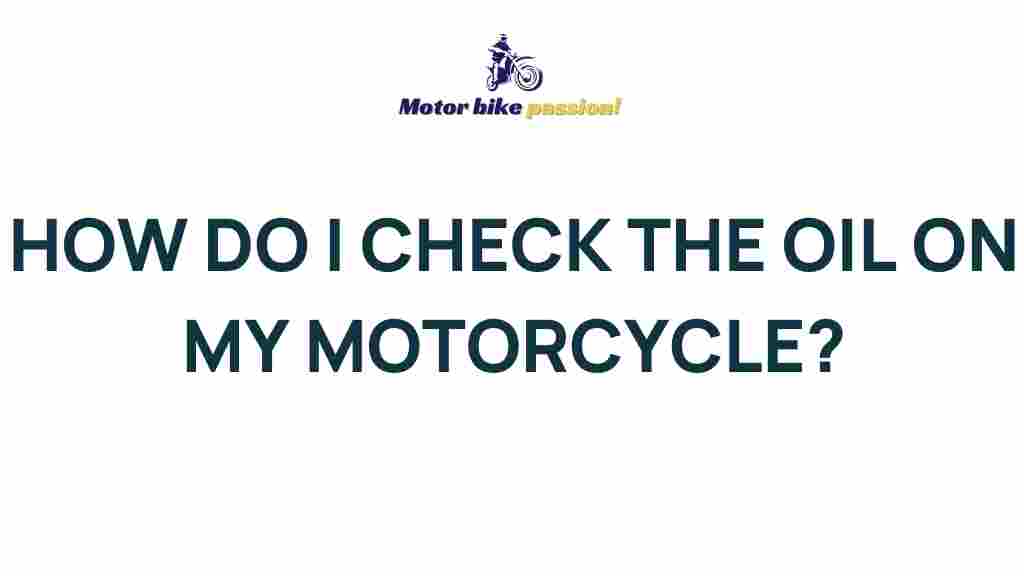Unveiling the Mysteries of Motorcycle Maintenance
Motorcycle maintenance is an essential aspect of owning a bike that ensures both performance and longevity. Whether you are a seasoned rider or a new enthusiast, understanding how to properly care for your motorcycle can save you time and money while enhancing your riding experience. One of the key components of motorcycle maintenance is regularly checking the oil, which plays a critical role in maintaining engine health. In this article, we will delve into the essential aspects of DIY motorcycle maintenance, focusing on oil checks, vehicle care, and tips for enhancing your bike’s engine performance.
Understanding the Importance of Motorcycle Maintenance
Regular motorcycle maintenance is crucial for several reasons:
- Safety: A well-maintained motorcycle reduces the risk of accidents due to mechanical failure.
- Performance: Regular checks and maintenance enhance the overall performance of your bike.
- Resale Value: A well-cared-for motorcycle retains its value better than one that has been neglected.
- Engine Health: Proper maintenance contributes to the longevity of your engine and other essential components.
Essential Tools for Motorcycle Maintenance
Before diving into the specifics of checking oil and conducting other maintenance tasks, it is vital to have the right tools on hand:
- Wrenches and sockets
- Screwdrivers (flathead and Phillips)
- Oil filter wrench
- Torque wrench
- Funnel
- Rags and cleaning supplies
- Owner’s manual (for specifications)
Step-by-Step Guide to Checking Oil
Checking the oil in your motorcycle is a straightforward process that should be done regularly, ideally before each ride. Here’s a step-by-step guide:
Step 1: Gather Necessary Tools
Ensure you have your tools ready, especially a clean rag and a funnel for pouring the oil.
Step 2: Warm Up the Engine
Start your motorcycle and let it run for a few minutes. This helps to circulate the oil throughout the engine, providing a more accurate reading.
Step 3: Turn Off the Engine
After warming up, turn off the engine and wait for about 2-3 minutes for the oil to settle back into the sump.
Step 4: Locate the Oil Dipstick or Sight Glass
Most motorcycles have either a dipstick or a sight glass to check oil levels. Refer to your owner’s manual to find its exact location.
Step 5: Check the Oil Level
If your motorcycle has a dipstick:
- Remove the dipstick, wipe it clean, and reinsert it without screwing it back in.
- Remove it again to check the oil level. It should be within the marked range.
If your motorcycle has a sight glass:
- Simply look at the glass to see if the oil level is within the acceptable range.
Step 6: Add Oil if Necessary
If the oil level is below the minimum mark, it’s time to add oil. Make sure to use the type of oil specified in your owner’s manual. Use a funnel to avoid spills, and add a small amount at a time, rechecking the level after each addition.
Step 7: Check for Leaks
After checking and topping off the oil, take a moment to inspect the area around the engine for any signs of leaks. If you discover a leak, it may indicate a more serious issue that requires attention.
Step 8: Dispose of Used Oil Properly
Always dispose of used oil in accordance with local regulations. Many auto parts stores or recycling centers accept used oil for safe disposal.
Additional Motorcycle Maintenance Tasks
While checking oil is vital, there are several other maintenance tasks you should regularly perform:
1. Tire Pressure and Condition
Check tire pressure regularly and inspect for wear and tear. Properly inflated tires are crucial for safe riding and handling.
2. Brake Fluid and Brake Pads
Regularly check the brake fluid levels and the condition of your brake pads. Worn-out pads can compromise your safety.
3. Chain Maintenance
Inspect the chain for lubrication and wear. A well-lubricated chain ensures smooth operation and reduces wear on sprockets.
4. Battery Care
Check the battery terminals for corrosion and ensure the battery is charged. Clean the terminals if necessary.
5. Air Filter Inspection
A clean air filter is essential for optimal engine performance. Inspect and clean or replace it as needed.
Troubleshooting Common Motorcycle Issues
Even with regular maintenance, issues can arise. Here are some common problems and troubleshooting tips:
1. Engine Won’t Start
- Check the battery: Ensure it is charged and terminals are clean.
- Inspect the fuel system: Check for fuel leaks and ensure the tank is full.
- Look for blown fuses: A blown fuse can prevent the electrical system from functioning.
2. Overheating Engine
- Check coolant levels: Ensure the coolant is at the proper level.
- Inspect the radiator: Look for blockages or leaks.
3. Unusual Noises
- Identify the source: Pinpoint whether the noise is coming from the engine, brakes, or another area.
- Consult a mechanic: If you cannot determine the source, professional assessment may be necessary.
Conclusion
Regular motorcycle maintenance is vital for ensuring safety, enhancing performance, and prolonging the life of your bike. A significant part of this upkeep involves checking oil levels, which is a straightforward yet crucial task. By following a structured maintenance routine and addressing any issues promptly, you can enjoy a smoother and safer ride.
For more detailed guides and resources on motorcycle maintenance, consider visiting this comprehensive guide. Remember, taking care of your motorcycle not only benefits the vehicle but also enhances your overall riding experience.
Engaging in DIY motorcycle maintenance empowers you as a rider and ensures that you are in tune with your vehicle’s health. Happy riding!
For more tips and insights into vehicle care and maintenance, check out our other articles on vehicle maintenance.
This article is in the category Maintenance Tips and created by MotorBikePassion Team
